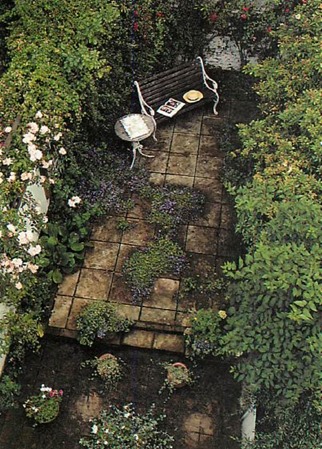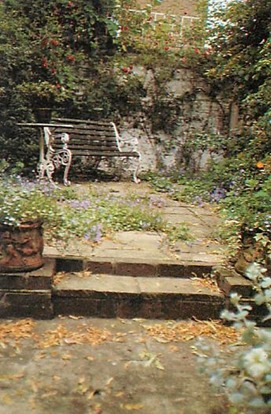





Mistakes can easily be made by taking the wrong decisions at planning stage, and I have been guilty of a few myself when aiming for a quick and inexpensive garden conversion on an addition to our cottage.
The result was that the economy was false and the low maintenance aspect of the garden totally unsuccessful; and if that wasn’t bad enough, the garden looked very dull and it was an extremely hard area for which to find plants, as the beds were so tiny nothing would squeeze in them.
So I was left with no option but to cram into the ‘cracks’ (masquerading as beds) small plants like pansies or London Pride (Saxifraga umbrosa) as very little else would fit. It was even difficult to plant climbing plants as the space was so small. Had I planned the beds only 9 in (22.5 cm) wider, as advised, it would have made all the difference.
As it is, the lines are straight and unimaginative with pencil-slim beds. It was only due to my own stubbornness that the beds were so narrow; I imagined in the early days of my passion for low maintenance gardening that the smaller the beds, the easier they would be to manage.
But this was not the case. Firstly, the small beds were at the expense of decent trouble-free plants and, secondly, maintaining such narrow beds can be labour-intensive in itself, especially if you wish them to grow something more than London Pride, pansies and bulbs. Therefore to bring variety you are obliged to plant summer bedding plants each spring and then live with the garden being without interest or colour in the winter.
As you look into the garden from the house, the steps are too small, the run of bricks so close to the tiny beds it is lost, and the straight lines confining and uninteresting. The overall impression is unimaginative and claustrophobic.
 But if the beds on either side had been irregular with two square inlets or a circle in the middle, the planting would have been much easier and the view from the kitchen window altogether better, as all the paving would not have been presented at once. It also would have been a more pleasant place to spend a sunny Sunday afternoon. Added to which the large variety of trouble-free and pleasing plants that could have been planted in the garden (had the beds been wider) would have made the garden a more attractive extension of the house.
But if the beds on either side had been irregular with two square inlets or a circle in the middle, the planting would have been much easier and the view from the kitchen window altogether better, as all the paving would not have been presented at once. It also would have been a more pleasant place to spend a sunny Sunday afternoon. Added to which the large variety of trouble-free and pleasing plants that could have been planted in the garden (had the beds been wider) would have made the garden a more attractive extension of the house.
In the end to ‘cover over the cracks’ and hide the ‘desolate’ square concrete look, I have planted and let run wild Campanula portenschlagiana between the concrete paving slabs, and bergenia to break up the straightness of the lines of the beds. The bergenia had to be planted when the leaves were one sixth of their full size in order to get them in and the camellia and hydrangea have to ‘lean’ out of the bed to get sunlight and air as they had to be planted so close to the wall. If it wasn’t for the garden furniture and the climbers, the terracotta pots and the vigorous campanula now growing everywhere, the garden would be pretty desolate.
Unwisely, I ignored the constructing landscaper’s advice and opted for economy at all costs. I am glad to say I have learnt by these mistakes.
So:
1. Don’t rush plans.
2. Don’t cut corners without considering the long term effects.
3. Do the garden in stages if you can’t afford everything you want at the same time.
 Many of the plant names seem so long and complicated one wonders why we can’t all use the plant’s ‘common name’. Unfortunately the only certain way to identify a plant accurately is by using its Latin name; the common name is too vague and unreliable. It’s not just that expert gardeners and horticulturists use the Latin names to show off (although there are a fair number of them who do), they use them because the Latin name is precise.
Many of the plant names seem so long and complicated one wonders why we can’t all use the plant’s ‘common name’. Unfortunately the only certain way to identify a plant accurately is by using its Latin name; the common name is too vague and unreliable. It’s not just that expert gardeners and horticulturists use the Latin names to show off (although there are a fair number of them who do), they use them because the Latin name is precise.
I have always been terrified of Latin plant names myself, and I have put up much resistance to calling plants by them, although I appreciate that if I go into a garden centre and ask for a shrubby cinquefoil, not many of the assistants will know what it is. There are many varieties of potentilla, so if what I want is a Potentilla fruticosa Longacre and I only ask for potentilla, I could land up with Potentilla Kathleen Dykes which grows over 3 ft (1 m) high and is tall and slim — not at all like a Potentilla fruticosa Longacre that has a mat habit and spreads to over 3 ft (1 m) wide!
The rest of this section concentrates on the practicalities of making a trouble-free garden: the nitty gritty of how to plant, what plants to choose, selecting an object to create a feature, lighting, paving, fencing, planting on a slope, etc.
Plant association and the natural structure of the woodland, which is the basis of trouble-free gardening, shows the logic behind the choice of plants chosen for the garden designs and for the plant lists suitable for a ‘little work’ garden.
Not everyone will wish to design, plan and build a whole garden from scratch. But some of you may wish to rethink your planting scheme and include a higher percentage of trouble-free plants in your garden.
Copyright © www.100flowers.win Botanic Garden All Rights Reserved